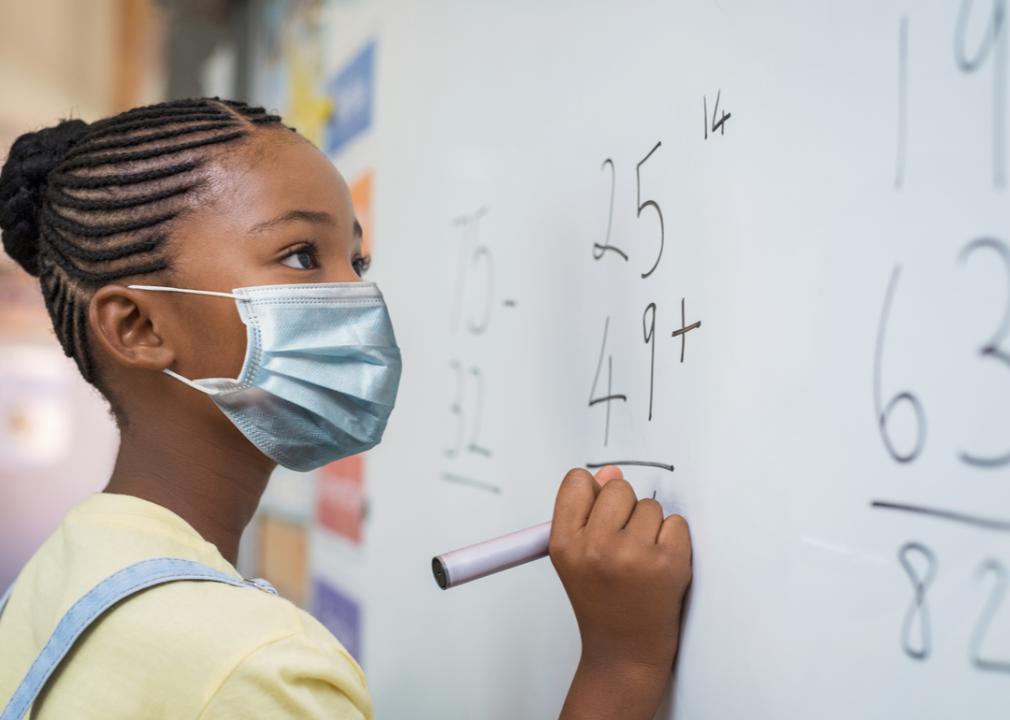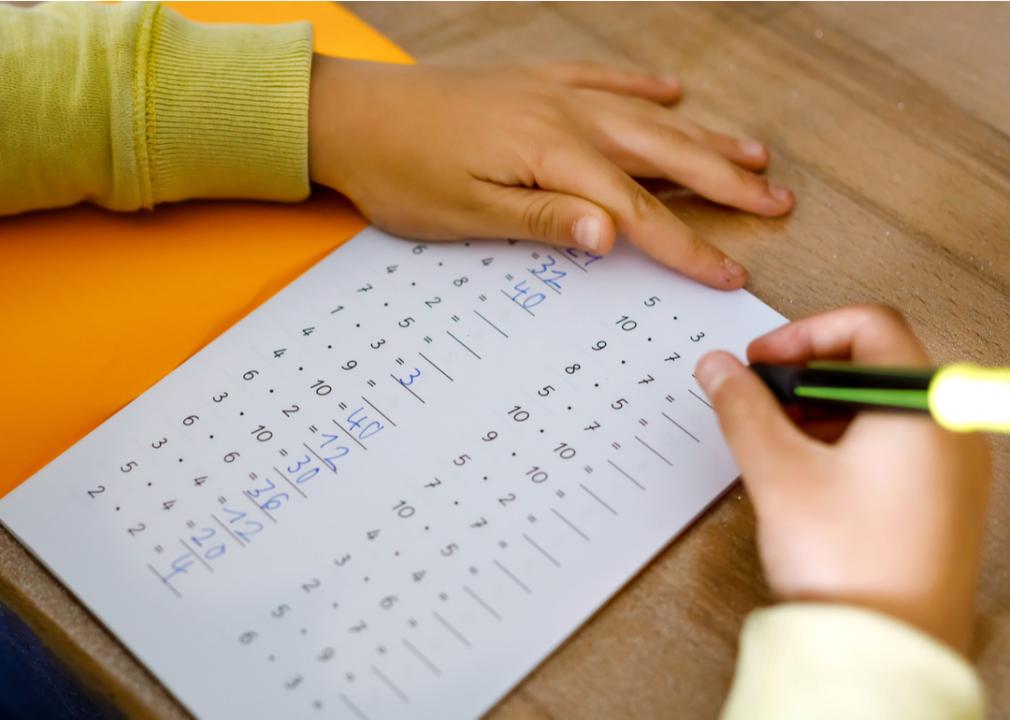Classroom test scores were already dropping in early 2020—then the pandemic happened
Published 5:30 pm Monday, April 25, 2022
Drazen Zigic // Shutterstock
Classroom test scores were already dropping in early 2020—then the pandemic happened
At the end of the 2020 school year, students in grades three to eight were typically behind 8–12 points in math and 3–6 points in reading, according to Northwest Evaluation Association data released in 2021.
Test scores remain a strong indicator of learning loss, even when considering how the temporary closing of schools affected testing veracity. In order to break down precisely how these declining trends in math and reading have affected various demographics among all students, HeyTutor looked at the drop in test scores in reading and math for fourth and and eighth grade students before and after COVID-19. This article cites long-term trend data from the National Assessment of Educational Progress along with information from other news reports and studies.
Prior to the pandemic, long-term trends showed that math and reading scores for students ages 9 and 13 had fallen or remained the same since 2012, according to the NAEP. Since 1971, the organization, which operates under the auspices of the U.S. Commissioners of Education, has tracked how students ages 9, 13, and 17 are performing in math and reading.
NAEP notes that while average test scores in math and reading in 2012 surpassed those of the 1970s for students ages 9 and 13, average scores among 13-year-old students decreased between 2012 and 2020. Specifically, average math scores for 13-year-old students in the 10th, 25th, and 50th percentiles decreased between 2012 and 2020.
Average math scores for 9-year-old students in the 10th and 25th percentiles also fell during the same time period. Additionally, average reading scores for 13-year-old students were higher in 2012 than they were in 2020, however, variations in average reading scores for 9-year-old students between 2012 and 2020 were negligible.
Continue reading for a closer look at how the COVID-19 pandemic disrupted education in America.
![]()

Rido // Shutterstock
Learning loss was greater among students in underserved schools
When schools transitioned to remote learning in the spring of 2020, students in low-income and underserved school districts faced many additional barriers, including those related to a lack of access to computers or tablets, dependable internet connections, caregivers or parents to assist with the learning process, and most importantly, teachers.
A December 2020 McKinsey & Company study also found that the pandemic-led school shutdowns disproportionately impacted communities of color. Only 79% of Black students had access to a computer or other digital device in the spring of 2020, according to data provided by the U.S. Census Bureau. An inability to connect to the internet sometimes resulted in missed classroom time: an average of 12 days in low-income school districts as opposed to eight days in higher-income districts.
The study also noted that lack of access to teachers on a live basis affected 16% of Hispanic students and 15% of Black students, while just 8% of white students experienced such difficulties. As live access to teachers is critical when it comes to certain subjects, students of color fell behind three to five months in math, while white students fell behind one to three months in the same subject.

Jaromir Chalabala // Shutterstock
Development in reading skills among elementary school students halted during early pandemic school closures
On the national level, researchers at the Stanford Graduate School of Education analyzed long-term student trends in reading skills from 2018 to the spring of 2020, publishing their findings on March 9, 2021.
When assessing children in grades one through four on their oral reading fluency, researchers noted that when schools closed in the spring of 2020, students failed to progress in terms of their ability to read aloud accurately and efficiently, a trend that continued throughout the summer of 2020.
Failure to progress was most acute among second graders and third graders, where their oral reading fluency was roughly 30% lower than would otherwise be demonstrated under normal circumstances. In the fall of 2020, researchers reported an increase in students’ oral reading fluency abilities that aligned with pre-pandemic growth trends. Unfortunately, those gains in reading ability proved insufficient when it came to overcoming the learning loss students experienced at the start of the COVID-19 pandemic.

Irina Wilhauk // Shutterstock
Subjects like math were especially impacted by remote learning restrictions
When schools closed in response to the COVID-19 pandemic, students who lacked access to formal, live learning or parents with sufficient expertise in math, or who struggled with math anxiety, fell behind in the subject—a situation educators refer to as “unfinished learning.”
In an Education Week special report dated Dec. 2, 2020, data provided by NWEA projected that in 2020–2021, students could fall behind an entire school year in math as a result of the pandemic. Specifically, researchers at NWEA compared test scores for approximately 4.4 million students assessed in the fall of 2019 with those assessed in the fall of 2020 (grades three through eight). Data showed an average 5–10 percentile-point difference in math scores between fall 2019 and fall 2020, with Black and Hispanic students in grades four through six experiencing the most significant loss of learning.
In another study conducted by McKinsey & Company and published in July 2021, during the 2020–2021 school year students in grades K-12 typically fell behind five months in math. During this same period of time, children enrolled in schools where the student body was predominantly Black or from low-income households experienced six and seven months of learning loss, respectively.

JR-50 // Shutterstock
As schools resumed in-person instruction, students of color were less likely to be enrolled full-time
According to a March 2021 ABC News report, during the COVID-19 pandemic, school systems nationwide reported that thousands of their students were unaccounted for or missing. In the spring of 2020, 30% of principals overseeing schools populated by students of color and/or those from low-income families had trouble contacting those students. This figure differs dramatically from those principals overseeing schools populated by students from higher-income, mostly white families, where 14% of students were designated as missing.
In a report issued by the U.S. Department of Education in June 2021 on its Monthly School Survey Dashboard, the National Center of Education Statistics noted that as of March 2021, just 18% of Asian, 35% of Latino, and 36% of Black students were attending class full-time and in person at schools serving fourth graders, as compared to 58% of white students.
Notably, while Black students account for 14% of minors in the U.S., 20% of them had a parent who died as a result of contracting COVID-19 through the early part of 2021, also according to the NCES report.

BearFotos // Shutterstock
Chronic absenteeism has increased, further complicating learning loss
Prior to the onset of the COVID-19 pandemic, in rural school districts where geographic isolation and poverty impact students’ ability to attend class on a regular basis, chronic absenteeism was already a problem in a population with historically low rates of attendance. As the pandemic took its toll, students who were afraid of contracting the virus, have ongoing behavioral or mental health issues, or have simply fallen out of the habit of attending class due to school closures also accounted for cases of chronic absenteeism.
In a July 2021 article, McKinsey & Company reported that cases of chronic absenteeism increased by 12% for students in grades eight through 12 since the onset of the pandemic, with 42% of the newly absent failing to attend class at all, as determined by a nationwide parent survey administered by the organization.
Normalizing this data on a national level indicates that, while 3.1 million students in grades eight through 12 were chronically absent from school prior to the start of the pandemic, in 2021 an additional 2.3–4.6 million students in grades eight through 12 were chronically absent.
In terms of learning loss, McKinsey estimates that if educators cannot successfully bring children back into the learning process, anywhere from 617,000 to 1.2 million students in grades eight through 12 may abandon their classrooms, given the historical relationship between being chronically absent and permanently dropping out of school.
This story originally appeared on HeyTutor
and was produced and distributed in partnership with Stacker Studio.






